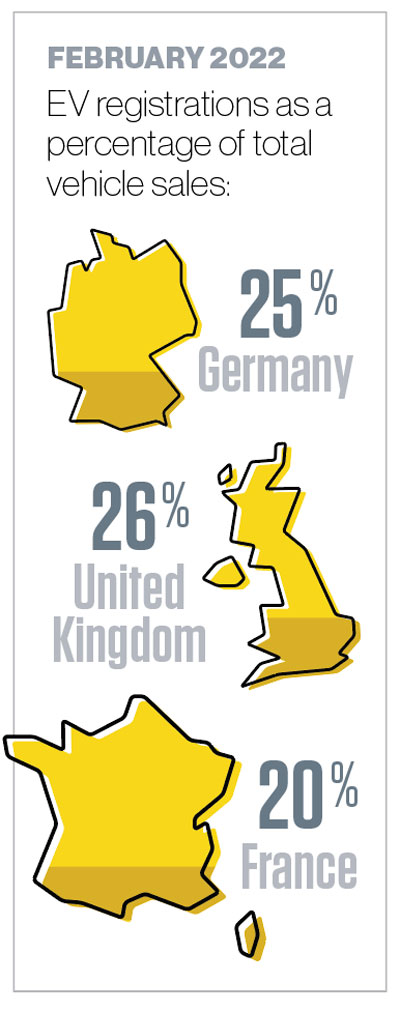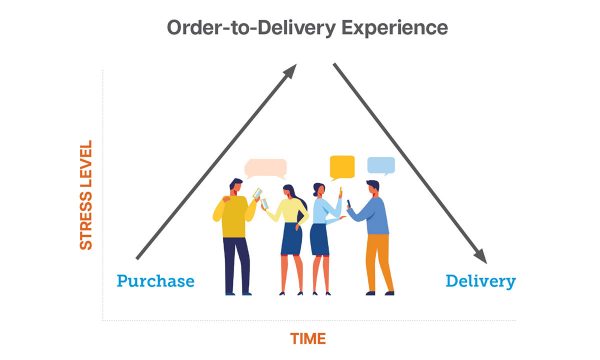What can Canadians learn from the European experience with selling electric vehicles?
The Canadian auto dealer team asked me to reflect on lessons learned from the growth of electric vehicles (EVs)—battery electric vehicles (BEVs) and plug-in hybrids (PHEVs)—over recent years in the UK and Europe, and what Canadian dealers and OEMs could do better to support the consumer transition to electric.
The dangers of making such broad comparisons are obvious at any time but even more challenging during a period of restricted vehicle supply, and concerns around energy security as Putin wages his odious war in Ukraine. However, I accept the challenge.
Sales of electric vehicles in the top three auto markets in Europe continue to break records: February 2022 EV registrations reached 25 per cent of total vehicle sales in Germany, 26 per cent in the United Kingdom, and 20 per cent in France.
The smaller markets of the Netherlands (EV share of 28 per cent), Sweden (52 per cent) and Norway (86 per cent) show how far it can and likely will go. Compared to less than 6 per cent EV sales in Canada in 2021, Europe is considerably farther along the EV adoption journey.
As the prominent German economist Rudiger Dornbusch famously remarked: “…in economics, things take longer to happen than you think they will, and then they happen faster than you thought they could.”
It is now clear that EV adoption in Europe has surpassed the early adopter stage and now is hurtling down the Autobahn towards mass adoption.
For example, Tesla outsold Porsche in Germany in 2021, Nissan Leaf was the fastest selling used vehicle in the UK last year, and the Fiat 500e is proving to be an increasingly trendy EV for the growing number of low-emission zones and chic-urban centres in Europe.
The sales journey hasn’t been without its challenges. Aside from the obvious barrier of limited models on show (now thankfully starting to change with improved new models entering the market from all main legacy OEMs and challenger brands, alike), six areas have frustrated the European consumer, dampening EV adoption:
1. Unprepared sales channels: Both direct and brick-and-mortar sales networks across Europe have (and some continue to) struggle promoting the core benefits of EV ownership.
With limited information online, and often with ill-informed sales consultants, consumers often knew more about an EV model than the retailer. As a senior head of a leading UK automotive dealer group told me: “Salespeople were intimidated by these customers.”
With investments in training, however, OEMs and dealers have adopted a more product focused approach to selling EVs and forward thinking dealers are now better prepared to meet the needs of EV buyers. As European markets have transitioned from early adopters (highly informed) to mass market consumers (less informed than early adopters), automotive retailers are now back in the driver’s seat.
2. A smorgasbord of terms: EV terms are a nightmare, ranging from inconsistent references to range measures (WLTP versus kWh/100 km), multitude of charge types: CHAdeMO, CCS, Type 2, Tesla Type 2, Rapid DC, etc. as well as confusion around charging times, capacity requirements and charging limits.
Even the home wallbox can be a 3kW, 7kW, 11kW or even higher if you can afford one and your vehicle accepts it, making any consumer’s head spin. Successful EV retailers understand that buyers can be confused and provide their customers with simplified explanations and access to key market-wide information resources.
3. Lacklustre promotions: Despite significant retail advertising and promotion, European retailers initially witnessed more interest among fleet buyers as companies and local authorities were mandated to deliver on their sustainability goals.
The promotion of many new EVs failed to excite new private (retail) buyers, save for Tesla, and a few other players. EVs were promoted to the masses with limited appeal. Fortunately, OEMs and retailers now promote tech, driving fun and convenience, dialling-down on environment attributes and removing dull engineering references.
4. Struggling to communicate Total Ownership Costs (TOC): Consumers (and arguably brands) aren’t clear how to calculate the cost of EV ownership. It remains badly communicated to buyers, with confusion around varying charging costs (home, public, work, etc.) maintenance requirements, and anticipated residual values in favour of promoting headline incentives and grants to countenance the higher ticket price. EVs are not effectively promoted as good value for money.

5. Constantly changing incentives and government grants: The sheer variety of incentives and government grants covering not only new vehicle purchases and the installation of home charging wallboxes, but road duties, business taxes and other benefits in kind, add to the complexity for the consumer.
Further, consumer rebates came with variations related to specific vehicle segments and types, as well as the timeframes applied to each offer. All told, the experience for buyers felt more like an accounting exercise than a straightforward and enjoyable purchase. Successful EV retailers became adept at simplifying and guiding the customer through this maze.
6. Fragmented and limited charging infrastructure: The rapid growth of public charging points typically hasn’t matched the demand where EV owners travel, creating frustration among queuing drivers or unused charging points in locations with low EV density.
Pricing and charging speeds, which are typically badly signed, vary greatly. Moreover, the inoperability of charging stations to accept universal payments, preferring specific Apps or membership RFID cards reduces the access to public charging points for many EV drivers.
It also increases anxiety among owners and dampens consideration among the sizable population reliant on street parking. Retailers have risen to the challenge by encouraging EV buyers to use the best aggregator charging network apps, educate them on journey planning, and providing access to their own free charging stations.
Greens shoots of growth
Despite these challenges, it is encouraging to see the introduction of a large selection of new models entering the European markets across all segments. Increasingly the EV ecosystem is becoming more integrated:
Utility companies and insurance players are now offering EV-tailored tariffs and premiums;
Subscription platforms are being introduced to promote adoption outside of longer, fixed-term financing; and
Concerns related to energy security, alongside a sizable environmental lobby in Europe, is promoting ever greater use of renewables and a focus away from fossil fuels.
Baker said that as EVs are more attractive to female buyers with a greater focus on tech, interiors, sustainability, and fun to drive attributes, OEMs and retailers need to move further away from old ICE references related to torque, engine size, and power.
Untapped potential
However, one major untapped market remains in the automotive industry—its inability to engage fully with female buyers.
A recent study by AutoTrader UK revealed that 20 per cent of women hadn’t considered an EV as their next vehicle compared to only 10 per cent for men. Further, 62 per cent of women were not aware of any government grants available.
“There’s a huge communication piece that is missing between the car industry and women.” says Erin Baker, Editorial Director at AutoTrader. “I think that is partly because women want to be talked to in a slightly different way about cars.”
Baker said that as EVs are more attractive to female buyers with a greater focus on tech, interiors, sustainability, and fun to drive attributes, OEMs and retailers need to move further away from old ICE references related to torque, engine size, and power.
Implications for Canada
So, what does all of this EV transition experience in Europe mean for Canada? In my view, there are five key lessons for Canadian OEMs, dealers and related industry stakeholders:
- To accelerate EV adoption, there needs to be clearer, uncluttered communication around each product’s key benefits, including clarity as to the cost of running an EV over a 1, 2 and 3 year period;
- Requirement for the EV ecosystem of players, including government, to work together to enhance interoperability, price transparency, range metrics and charging standards, all key aspects of the EV experience;
- The charging infrastructure needs to grow in-line with vehicle adoption;
- Consumer incentives should be used innovatively, with clear guidelines and timeframes; and
- The wider market must also embrace and address the unique needs of women to accelerate EV consideration and adoption.
As we’ve seen from Europe, the market can move faster than first expected, so best to be prepared now for tomorrow’s rapid growth.












